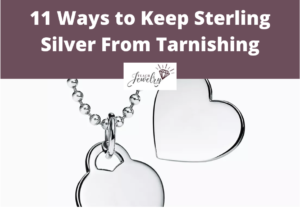
Sterling silver is a popular metal for jewelry because of its brilliant, bright aesthetic and versatility. The compound consisting of 92.5% pure silver and 7.5% harder metals such as copper or nickel is far more durable than its pure silver counterpart.
Though it has many advantages in jewelry, sterling silver is prone to tarnishing. It results in a darkened, dirty look that turns black over time.
Fortunately, there are ways to prevent sterling silver from tarnishing, and if tarnish does develop, it can be removed to restore your jewelry’s shine.
Our bottom line recommendation is to use these anti-tarnish strips, but let’s explore all the details you need to know about how to keep sterling silver from tarnishing.
What Causes Sterling Silver to Tarnish?
Sterling silver tarnishes as a result of oxidation when it comes in contact with particles in the air. It’s primarily the other metals mixed with pure silver, such as copper, that cause it to tarnish.
When it’s exposed to moisture and sulfur, especially in areas with high humidity or air pollution, it starts to wear down.
The speed at which it tarnishes depends on the extent it’s exposed to the elements that cause it.
In most cases, it’ll take at least two years to begin tarnishing. But if you wear the pieces frequently and don’t take steps to prevent it, your sterling silver could show signs of tarnish within a few months.
How to Prevent Sterling Silver From Tarnishing
Tarnish is inevitable, so the goal is to slow down the process as much as possible.
There are many steps to take in preventing sterling silver from tarnishing, which include taking proactive steps on how it’s stored, worn, and cleaned.
1. Keep it Out of Direct Sunlight
It might be tempting to showcase your sterling silver jewelry on a bright, sunny day, but this can accelerate tarnishing.
Although the light will improve its shine in the moment, sterling silver better maintains its color when in cool, dark areas.
That doesn’t mean you can’t wear it outside. You won’t hasten the tarnishing process by exposing it for a few hours, but if it’s consistently in the sunlight, you might start to notice some tarnish.
2. Put Sterling Silver Jewelry on Last
It might be your favorite part of the outfit, but put sterling silver jewelry on last when you’re getting dressed.
The chemicals present in accessories such as hair spray, perfume, body lotion, and makeup can land on your jewelry and cause tarnish.
By saving your sterling silver jewelry for last, you can ensure the process of preparing to go out doesn’t cause those chemicals to rest on your jewelry for hours at a time.
3. Remove Before Household Cleaning and Chores
The same issue can result from household cleaning. Common cleaning products used around the house don’t mix well with sterling silver jewelry.
Whether you’re spraying countertops, cleaning mirrors and windows, or doing the dishes, these activities have the potential to damage your sterling silver and add tarnish.
Remove the jewelry before any of these tasks in order to play it safe.
4. Add Chalk to the Container
Storing sterling silver jewelry with chalk can absorb the moisture and chemicals in the air that accelerate tarnishing.
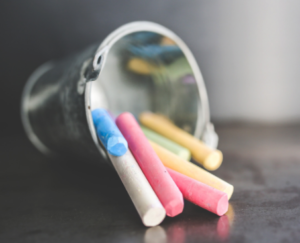
No matter where it’s stored, some degree of humidity will be present, so the best solution is to use chalk to minimize the extent it causes discoloration.
Wrap the sticks of chalk in cheesecloth to keep it looking brand new for longer.
5. Avoid Placement on Stained Wood
Surfaces treated with chemicals can also cause sterling silver to tarnish.
If your countertops, furniture, or cabinets include stained wood, you should avoid placing your jewelry on top.
It’ll speed up tarnishing and leave stains on your sterling silver.
6. Store it Properly
A necessary step to preventing sterling silver jewelry from tarnishing is to store it properly, in a dry, cool place. There are a variety of containers that will work, but plastic bags that zip closed are the most popular.
Place just one piece in each bag, and squeeze all the air out before locking it tight. If you place multiple pieces in the same bag, you might prevent tarnish, only to cause scratches.
One additional note is to ensure the bags don’t contain polyethylene because it’s an abrasive substance that may also cause damage.
If you opt for a material other than plastic bags, don’t choose boxes made of paper or cardboard. The sulfur that’s sometimes present can cause tarnishing.
7. Include Anti-Tarnish Strips
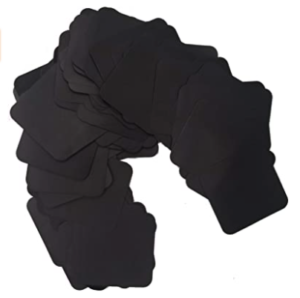
Anti-tarnish strips can also be added to the storage containers. These strips serve a similar function as chalk in that they’re designed to absorb the particles in the air that cause tarnishing.
They’re made of non-toxic chemicals, so you don’t have to worry about the material solving one problem but causing another.
There’s no need to wrap the pieces of sterling silver jewelry in the anti-tarnish strips. Place both items in the bag and seal it tight.
You also don’t need to use one strip for every piece of jewelry. A couple rings or a ring and necklace can be placed in the same bag with an anti-tarnish strip.
8. Keep Sterling Silver Dry
It’s important to not bathe, shower, or get in the pool with your sterling silver. The humidity of the shower will speed up oxidation, and the chlorine in a pool will cause more damage to it than only tarnishing.
You should instead store them in a dry place where they won’t be at risk of exposure to humidity, and keep them far away from the types of chemicals that wear it down.
9. Consider Silica Packs
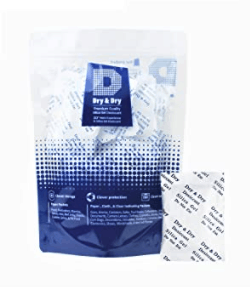
Silica packs, like these, are commonly included with new clothes and shoes. They keep the items free from moisture, which would also cause them to wear down over time.
Save your silica packs and toss them in your sterling silver storage container. It’s important the container you’re using is sealed tightly to keep air out.
The silica packs won’t work if new air is constantly being let into the container, so they’ll become saturated.
10. Use Jewelry Protectant Spray
Anti-tarnish treatments are also available as a protectant spray. This spray provides a layer of protection against tarnish, but after you coat it, make sure to clean it and then leave it to dry.
There’s some concerns these sprays can leave residual color on the sterling silver, so ensure you find a version that’s colorless.
Once it’s cleaned and dried, it should look like it never had the spray on to begin with.
In comparing anti-tarnish strips, silica packs, and protectant spray, I recommend starting with the anti-tarnish strips. They’re inexpensive and easy to use.
11. Wear it Often
You might assume wearing sterling silver jewelry often would cause it to tarnish faster. But the opposite is true.
When you wear it throughout the day, the oils on your skin actually keep it shining. This helps counter the process of tarnishing when its unused in a jewelry box.
There’s no exact formula to how often you should wear it to prevent tarnishing, but when you take the pieces off at night, store them properly.
How to Remove Tarnish
No matter how much you work to prevent tarnish, it’s difficult to keep it away entirely.
Once your sterling silver jewelry has earned some tarnish, you don’t have to get rid of the pieces.
There are effective ways of removing tarnish you can do at home.
Soap and Water
The first step to take in removing tarnish from sterling silver jewelry is to wash it with water and a mild dishwashing soap. This technique is the same as for other jewelry.
Run the pieces under warm water with the soap, and then lightly pay them dry with a soft cloth. Leave them out to dry and them store them in a dry container.
Anti-Tarnish Cloths
Another way of removing tarnish already present on your sterling silver jewelry is to wipe it with an anti-tarnish cloth.
There are polishing cloths specifically designed for this metal that clean mild amounts of tarnish without damaging the underlying metal. Again, be gentle in how you wipe it to avoid any damage to the pieces.
Water and Baking Soda
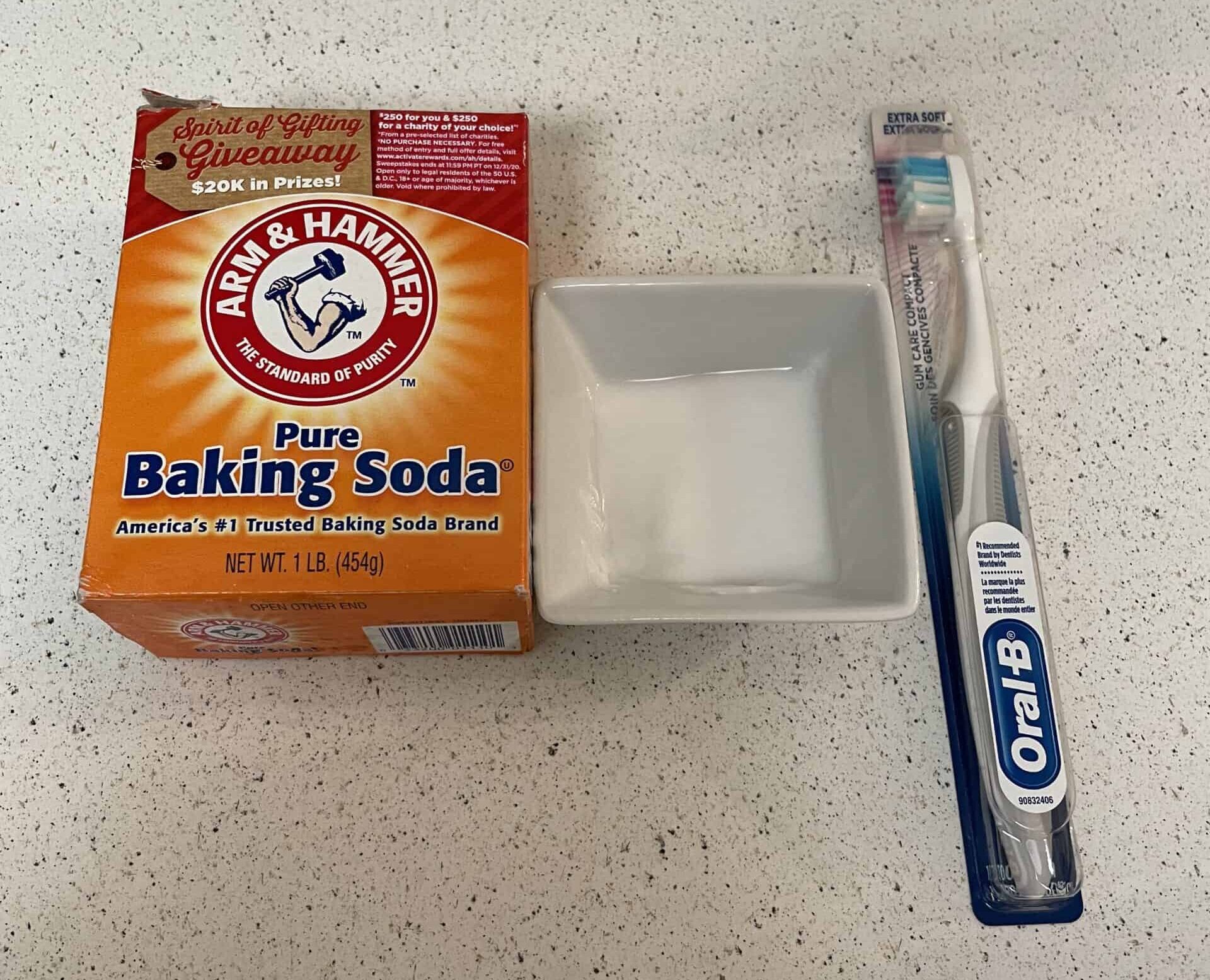
You can also substitute dishwashing soap for baking soda. Combine a couple teaspoons of baking soda with warm water, and gently wash your sterling silver.
Baking soda is more abrasive than soap, so it’s recommended you use a toothbrush to clean it carefully and avoid any scratches. Pat the pieces dry with a soft cloth and allow them to fully dry.
Avoid Toothpaste
It’s common advice to clean your sterling silver jewelry using toothpaste. While this may be successful, there are certain types of toothpaste with chemicals in them that could cause damage.
It’s best to play it safe and use one of the other methods for removing tarnish. You’re better off having minor amounts of tarnish on them rather than damage the other piece trying to scrape every last bit off the jewelry.
Professional Jewelry Cleaner
If you aren’t confident with an at-home method, or your sterling silver is severely tarnished, you can always take it to a professional jewelry cleaning service.
They’ll have the best materials and technique to restore the shine of your jewelry, and you won’t have to worry about a do-it-yourself job gone awry.
Even though you’ll pay a higher fee for professional cleaning than an at-home method, it’s generally less expensive than having to replace them with new ones.
Conclusion
It’s difficult to prevent sterling silver from tarnishing, even if you wear it often and store it properly. It reacts with particles in the air and begins darkening, losing the luster it once had.
The best way to keep tarnish from damaging your jewelry is to prevent it from happening in the first place. Follow precautions such as storing it in a cool, dry place with anti-tarnish material.
Once it experiences the wear and tear, begin with a gentle clean using soap and water, and move forward with additional methods from there.
Through strong prevention techniques and the right ways to remove tarnish, you’ll own sterling silver jewelry that can shine for years to come.

Jacob Clarke
Jacob Clarke is the founder of TeachJewelry.com.
He earned an Applied Jewelry Professional Diploma from the Gemological Institute of America (GIA) and now brings you essential information about diamonds, settings, and more.
Jacob has consulted with leading jewelry brands, and his work has been cited in Clean Origin, Diamond Nexus and industry publications.
He's also a member of the International Gem Society.
He enjoys discussing jewelry with readers, so contact him with any questions at jacob.clarke@teachjewelry.com.













